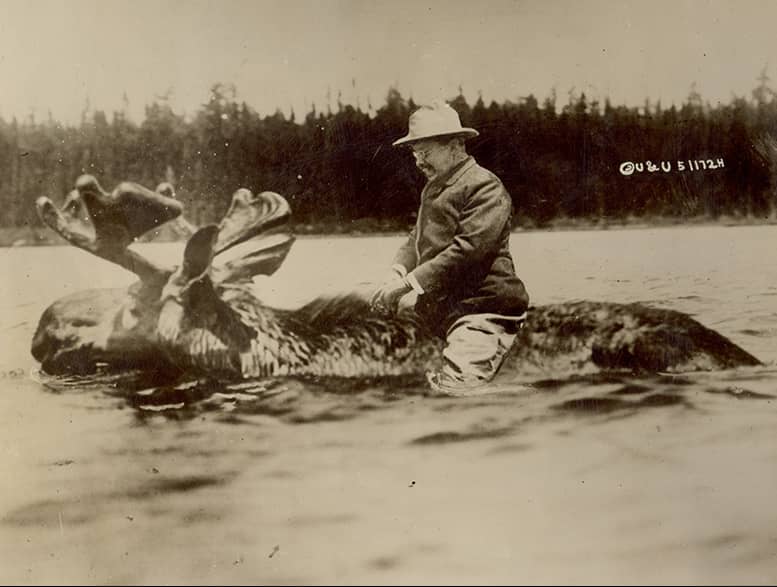Iconic Image of Roosevelt Riding a Moose Deemed Forgery
Daniel Xu 10.03.13

Theodore Roosevelt is one of the most highly regarded presidents in United States history, having been a Nobel Peace Prize recipient, soldier, conservationist, and preeminent sportsmen. But, according to a recent blog post by Harvard’s Houghton Library, he did not ride a swimming moose—at least in one instance allegedly captured in a photograph. This picture has long been considered representative of the 26th President of the United States, who was known for his exuberant personality and love of the outdoors. It is not hard to imagine Roosevelt wrangling a wild moose for an impromptu raft in lieu of a bridge, but experts assert that the photo is a fake.
Heather Cole, Curator of the Theodore Roosevelt Collection at Harvard’s Houghton Library, says that the forgery is obvious. In a phone call, she explained that the image was originally created by the photography firm Underwood and Underwood to be part of a three-paneled cartoon, or triptych, for the New-York Tribune.
“It was used for the 1912 election,” Cole said. “It was an unusual election in that there were four parties, including the Democrats, the Republicans, and the newly formed Progressive party by Roosevelt. He had recently broken with the Republican party and the mascot of the Progressives was the moose.”
Three of the candidates were displayed riding the mascot of their respective parties. The Democratic candidate Woodrow Wilson was atop a donkey, Republican incumbent William Taft took an elephant, and Roosevelt rounded it out by riding a moose. Missing was Eugene Debs, the Socialist Party candidate.
None of the images were real.
“It was supposed to be humorous and was called ‘The Race for the White House,'” Cole explained.
Originally published in black-and-white, the images made for a convincing fake. Cole agreed that Underwood did a good job of the forgery, especially without the aid of modern day photo-editing software.
“Underwood probably took photographs of the three people displayed riding horses and glued them onto pictures of the animals,” Cole surmised.
A ripple could be seen where Roosevelt’s leg enters the water. Cole says that these kinds of alterations were likely done with scratching of the photograph or a swipe of the paintbrush. Unfortunately, despite the Houghton Library’s large collection of Roosevelt-related photographs, the original copy by Underwood cannot be found. Also missing is the base photograph of Roosevelt riding a horse which the firm used in the mock-up. Cole speculates that Underwood and Underwood may have captured that picture themselves.

For years the image of Roosevelt riding a moose circulated on the internet as another testament to Roosevelt’s already extensive reputation. While experts have more or less dismissed the image as fake, the common perception remained that the photo could be genuine. These doubts have lead to a steady trickle of emails to experts such as Cole.
“It is clearly fake and we just wanted to explain a little more on how it was created and what circumstances it was created for,” she said.
While Teddy couldn’t add moose-riding to his list of exploits, such a falsehood pales beside the legacy that he left behind. Few men have had such an impact on American politics, ideology, history, and even the preservation of its natural resources as Theodore Roosevelt. And, of course, he inspired the teddy bear.
You can read Heather Cole’s original blog post here.

